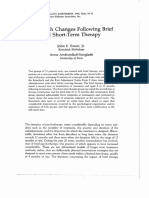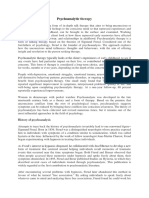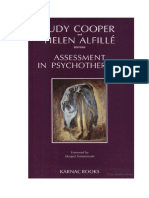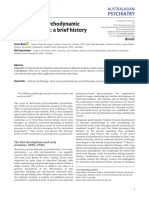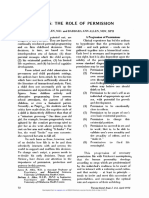MODULE 5 PSYCHODYNAMIC
Brief psychodynamic psychotherapy is a time-limited treatment (10 to 12 sessions) that is
based on psychoanalysis and psychodynamic theory.
In 1946, Franz Alexander and Thomas French identiϧed the basic characteristics of brief
psychodynamic psychotherapy. They described a therapeutic experience designed to put
patients at ease, to manipulate the transference, and to use trial interpretations flexibly.
Alexander and French conceived psychotherapy as a corrective emotional experience capable
of repairing traumatic events of the past and convincing patients that new ways of thinking,
feeling, and behaving are possible.
It is used to help persons with depression, anxiety, and posttraumatic stress disorder, among
others.
Practitioners of brief psychodynamic therapy believe that some changes can happen through
a more rapid process or that an initial short intervention will start an ongoing process of
change that does not need the constant involvement of the therapist. A central concept in
brief therapy is that there should be one major focus for the therapy rather than the more
traditional psychoanalytic practice of allowing the client to associate freely and discuss
unconnected issues (Malan, 1976). In brief therapy, the central focus is developed during the
initial evaluation process, occurring during the first session or two. This focus must be agreed
on by the client and therapist. The central focus singles out the most important issues and
thus creates a structure and identifies a goal for the treatment. In brief therapy, the therapist is
expected to be fairly active in keeping the session focused on the main issue. Having a clear
focus makes it possible to do interpretive work in a relatively short time because the therapist
only addresses the circumscribed problem area. When using brief psychodynamic approaches
to therapy for the treatment of substance abuse disorders, the central focus will always be the
substance abuse in association with the core conflict. Further, the substance abuse and the
core conflict will always be conceptualized within an interpersonal framework.
The number of sessions varies from one approach to another, but brief psychodynamic
therapy is typically considered to be no more than 25 sessions (Bauer and Kobos, 1987).
Crits-Christoph and Barber included models allowing up to 40 sessions in their review of
short-term dynamic psychotherapies because of the divergence in the scope of treatment and
the types of goals addressed (Crits-Christoph and Barber, 1991). For example, some brief
psychodynamic models focus mainly on symptom reduction (Horowitz, 1991), while others
target the resolution of the Oedipal conflict (Davanloo, as interpreted by Laikin et al., 1991).
The length of therapy is usually related to the ambitiousness of the therapy goals. Most
therapists are flexible in terms of the number of sessions they recommend for clinical
practice. Often the number of sessions depends on a client's characteristics, goals, and the
issues deemed central by the therapist.
�Differences between psychoanalysis and psychoanalytical psychotherapy
a. Therapeutic situation. Patients in analysis lie on a couch with the analyst seated
behind out of the patient’s field of vision. In psychoanalytic psychotherapy, patients
and analysts are seated face-to-face.
b. Frequency. Psychoanalysis has a frequency of three to five sessions per week.
Psychoanalytic psychotherapy has a frequency of one to three sessions per week.
Frequency is a function of the depth and intensity of the therapeutic work
needed.
c. psychotherapy deals with what we call the ego, the I or the active agency with which
you make decisions on a daily basis. In contrast, psychoanalysis deals with
the unconscious – those experiences that are beyond language, outside of our
awareness; the part of us that was vastly suppressed by culture, social norms, rules
and regulations.
d. the goals of psychoanalysis and psychotherapy are also different. Psychotherapy
attempts to restore a persons relationship to the social norms and regulations, while
psychoanalysis works to restore a person’s relationship to their sexuality.
Psychotherapy works to strengthen the ego, while psychoanalysis works to
strengthen the subject’s relationship to their own unconscious.
e. Psychotherapists use their relationship with you, the client, to influence your decision-
making, to teach coping strategies, change behaviors or thoughts, and to modify the
ways you relate to others. Psychoanalysts use their relationship with you to help you
reorganize the way you relate to yourself and your body with all its human qualities.
f. Duration. Psychoanalysis is long term, usually 3-5+ years. Psychoanalytical
psychotherapy could be short or long term.
g. Modus operandi. In psychoanalysis, a systematic analysis is done of all positive and
negative transference and resistance. In psychotherapy analysis of dynamics and
defenses and focus is given on current interpersonal events,
h. Patient prerequisites: in psychoanalysis- high motivation, psychological mindedness,
good frustration tolerance. In psychoanalytical psychotherapy-moderate to high
motivation, psychological mindedness, ability to form therapeutic alliance, some
frustration tolerance.
TYPES
Brief Focal Psychotherapy (Tavistock–Malan)
Brief focal psychotherapy was originally developed in the 1950s by the Balint team at the
Tavistock Clinic in London. Malan, a member of the team, reported the results of the therapy.
Malan’s selection criteria for treatment included eliminating absolute contraindications,
rejecting patients for whom certain dangers seemed inevitable, clearly assessing patients’
psychopathology, and determining patients’ capacities to consider problems in emotional
terms, face disturbing material, respond to interpretations, and endure the stress of the
treatment. Malan found that high motivation invariably correlated with a successful outcome.
Contraindications to treatment were serious suicide attempts, substance dependence, chronic
�alcohol abuse, incapacitating chronic obsessional symptoms, incapacitating chronic phobic
symptoms, and gross destructive or self-destructive acting out.
Requirements and Techniques. In Malan’s routine, therapists should identify the transference
early and interpret it and the negative transference. They should then link the transferences to
patients’ relationships with their parents. Both patients and therapists should be willing to
become deeply involved and to bear the ensuing tension. Therapists should formulate a
circumscribed focus and set a termination date in advance, and patients should work through
grief and anger about termination. An experienced therapist should allow about 20 sessions as
an average length for the therapy; a trainee should allow about 30 sessions. Malan himself did
not exceed 40 interviews with his patients.
Time-Limited Psychotherapy (Boston University–Mann)
A psychotherapeutic model of exactly 12 interviews focusing on a speciϧed central issue was
developed at Boston University by James Mann and his colleagues in the early 1970s. In
contrast with Malan’s emphasis on clear-cut selection and rejection criteria, Mann has not
been as explicit about the appropriate candidates for time-limited psychotherapy. Mann
considered the major emphases of his theory to be determining a patient’s central conϩict
reasonably correctly and exploring young persons’ maturational crises with many
psychological and somatic complaints. Mann’s exceptions, similar to his rejection criteria,
include persons with major depressive disorder that interferes with the treatment agreement,
those with acute psychotic states, and desperate patients who need, but cannot tolerate, object
relations.
Requirements and Techniques. Mann’s technical requirements included strict limitation to 12
sessions, positive transference predominating early, specification and strict adherence to a
central issue involving transference, positive identification, making separation a maturational
event for patients, absolute prospect of termination to avoid development of dependence,
clarification of present and past experiences and resistances, active therapists who support
and encourage patients, and education of patients through direct information, reeducation,
and manipulation. The conflicts likely to be encountered included independence versus
dependence, activity versus passivity, unresolved or delayed grief, and adequate versus
inadequate self-esteem.
Short-Term Dynamic Psychotherapy (McGill University–Davanloo)
As conducted by Davanloo at McGill University, short-term dynamic psychotherapy
encompasses nearly all varieties of brief psychotherapy and crisis intervention. Patients
treated in Davanloo’s series are classiϧed as those whose psychological conϩicts are
predominantly oedipal, those whose conϩicts are not oedipal, and those whose conϩicts have
more than one focus. Davanloo also devised a speciϧc psychotherapeutic technique for
patients with severe, long-standing neurotic problems, speciϧcally those with incapacitating
obsessive-compulsive disorders and phobias. Davanloo’s selection criteria emphasize
evaluating those ego functions of primary importance to psychotherapeutic work: the
establishment of a psychotherapeutic focus; the psychodynamic formulation of the patient’s
psychological problems; the ability to interact emotionally with evaluators; a history of give-
�and-take relationships with a signiϧcant person in the patient’s life; the patient’s ability to
experience and tolerate anxiety, guilt, and depression; the patient’s motivations for change,
psychological mindedness, and an ability to respond to interpretation and to link evaluators
with persons in the present and past. Both Malan and Davanloo emphasized a patient’s
responses to interpretation as an important selection and prognostic criterion.
Requirements and Techniques. The highlights of Davanloo’s psychotherapeutic approach are
flexibility (therapists should adapt the technique to the patient’s needs), control, the patient’s
regressive tendencies, active intervention to avoid having the patient develop overdependence
on a therapist, and the patient’s intellectual insight and emotional experiences in the
transference. These emotional experiences become corrective as a result of the interpretation.
Short-Term Anxiety-Provoking Psychotherapy (Harvard University–Sifneos)
Sifneos developed short-term anxiety-provoking psychotherapy at the Massachusetts General
Hospital in Boston during the 1950s. He used the following criteria for selection: a
circumscribed chief complaint (implying a patient’s ability to select one of a variety of
problems to be given top priority and the patient’s desire to resolve the problem in
treatment), one meaningful or give-and-take relationship during early childhood, the ability
to interact ϩexibly with an evaluator and to express feelings appropriately, aboveaverage
psychological sophistication (implying not only above-average intelligence but also an ability
to respond to interpretations), a speciϧc psychodynamic formulation (usually a set of
psychological conϩicts underlying a patient’s diϫculties and centering on an oedipal focus), a
contract between therapist and patient to work on the speciϧed focus and the formulation of
minimal expectations of outcome, and good to excellent motivation for change, not just for
symptom relief.
Requirements and Techniques.
Treatment can be divided into four major phases: patient–therapist encounter, early therapy,
height of treatment, and evidence of change and termination. Therapists use the following
techniques during the four phases.
PATIENT–THERAPIST ENCOUNTER. A therapist establishes a working alliance by using
the patient’s quick rapport with, and positive feelings for, the therapist that appear in this
phase. Judicious use of open-ended and forced-choice questions enables the therapist to
outline and concentrate on a therapeutic focus. The therapist specifies the minimal
expectations of outcome to be achieved by the therapy.
EARLY THERAPY. In transference, feelings for the therapist are clarified as soon as they
appear, a technique that leads to the establishment of a true therapeutic alliance.
HEIGHT OF THE TREATMENT. Height of treatment emphasizes active concentration on
the oedipal conflicts that have been chosen as the therapeutic focus; repeated use of
anxietyprovoking questions and confrontations; avoidance of pregenital characterological
issues, which the patient uses defensively to avoid dealing with the therapist’s anxiety-
provoking techniques; avoidance at all costs of a transference neurosis; repetitive
demonstration of the patient’s neurotic ways or maladaptive patterns of behavior;
�concentration on the anxietyladen material, even before the defense mechanisms have been
clarified; repeated demonstrations of parent-transference links by the use of properly timed
interpretations based on material given by the patient; establishment of a corrective emotional
experience; encouragement and support of the patient, who becomes anxious while struggling
to understand the conflicts; new learning and problem-solving patterns; and repeated
presentations and recapitulations of the patient’s psychodynamics until the defense
mechanisms used in dealing with oedipal conflicts are understood.
EVIDENCE OF CHANGE AND TERMINATION OF PSYCHOTHERAPY. The final
phase of therapy emphasizes the tangible demonstration of change in the patient’s behavior
outside therapy, evidence that adaptive patterns of behavior are being used, and initiation
of talk about terminating the treatment





























